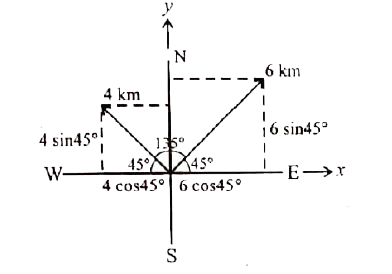A bus travels 6 km towards north at an angle of 45∘ to the east and then travels 4 km towards north at an angle of 135∘ to the east . How for is its final position , due east and due north ? How far is the point from the starting point ? What angle does the straight line joining its initial and final position makes with the east ? Solution in Tamil
Net movement along x-direction (due east)
=(6−4)cos45∘
=2×1√2=√2km
Net movement along y-direction (due north)
=(6+4)sin45∘
=10×1√2=5√2km
Net movement from starting point
= 6 + 4 = 10 km
Angle which makes with the east direction
tanθ=y-componentx-component=5√2√2
∴θ=tan−1(5) (or)
θ=79∘ (approx).

Topper's Solved these Questions
- BOOK - PREMIERS PUBLISHERSCHAPTER - KINEMATICS EXERCISE - Other important questions & answers (IV. Long answer questions).34videos
KINEMATICS
- BOOK - PREMIERS PUBLISHERSCHAPTER - GRAVITATIONEXERCISE - OTHER IMPORTANT QUESTION & ANSWERS (CONCEPTUAL QUESTIONS)34videos
GRAVITATION
- BOOK - PREMIERS PUBLISHERSCHAPTER - KINETIC THEORY OF GASESEXERCISE - OTHER IMPORTANT QUESTIONS & ANSWERS (VI. Conceptual Questions.)8videos
KINETIC THEORY OF GASES
Similar Questions
Define and illustrate the following terms.
Equal vectors.05:56View SolutionWhy a body weighs less at the equator than at the poles?
01:16View SolutionWhen an automobile travels for a long distance , the air pressure in the tyres increases slightly . Why ?
03:07View SolutionA car travles 6km towards north at an angle of 45∘ to the east and then travles distance of 4km towards north at an angle of 135∘ to east (figure). How far is the point from the starting point? What angle does the straight line joining its initial and final position makes with the east?
 01:50View Solution
01:50View SolutionCalculate the distance travelled by the car, if a car travels 4km towards north at an angle of 45^(@) to the east and then travels a distance of 2km towards north at an angle of 135^(@) to the est.
03:05View SolutionA body travel a distance of 3 km towards East, then 4 km towards North and finally 9 km towards East. (i) What is the total distance travelled ? (ii) What is the resultant displacement ?
02:52View Solutionसुहास ने पूरब की ओर 15 किमी यात्रा की ओर फिर उत्तर की ओर घूमकर 15 किमी यात्रा की और फिर पश्चिम की और घूमकर 15 किमी यात्रा की। वह प्रारम्भिक स्थान से कितनी दूर है?
03:42View Solutionएक कार प्रारंभिक स्थिति A से उत्तर की ओर 5 किमी फिर पूर्व की ओर 5 किमी जाकर दक्षिण की ओर 5 किमी चलती है इस यात्रा में कार 45 मिनट लेती है
कार द्वारा चली कुल दूरी |02:55View Solutionएक कार प्रारंभिक स्थिति A से उत्तर की ओर 5 किमी फिर पूर्व की ओर 5 किमी जाकर दक्षिण की ओर 5 किमी चलती है इस यात्रा में कार 45 मिनट लेती है
कार का विस्थापन |02:31View SolutionA man first travels 2 mile due east, then 6 mile due south, then 4 mile due east and finally 14 mile towards north. Then his displacement from the initial position (in mile) is _______.
06:33View SolutionA man travels 4 km due north, then travels 6 km due east and further travels 4 km due north. How far he is from the starting point ?
02:26View SolutionA small airplane leaves an airport on an overcast day and is later sighted 215km away, in a direction making an angle of 22 ^(@) east of due north. This means that the direction is not due north (directly toward the north) but is rotated 22^(@) toward the east from due north. How far east and north is the airplane from the airport when sighted ?
03:16View Solutionएक कार पूर्व से 45∘ कोण पर उत्तर की ओर 6 किमी चलती है तथा फिर पूर्व से 135∘ कोण पर उत्तर की ओर 4 किमी. दूरी तक चलती है। प्रारंभिक बिंदु से कार कितनी दूरी पर है। प्रारंभिक तथा अंतिम स्थिति को जोड़ने वाली रेखा पूर्व दिशा से क्या कोण बनायेगी
05:51View Solutionएक वस्तु 10 km उत्तर में 20 km पूर्व में गति करती है। वस्तु का प्रारम्भिक बिन्दु से विस्थापन बताइए ?
03:51View SolutionA car travles 6km towards north at an angle of 45∘ to the east and then travles distance of 4km towards north at an angle of 135∘ to east (figure). How far is the point from the starting point? What angle does the straight line joining its initial and final position makes with the east?
 02:08View Solution
02:08View Solution

